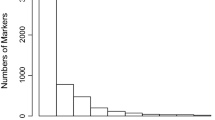Summary
The use of random amplified DNA fragments as genetic markers in Coffea was investigated. Arbitrary oligonucleotides were used as primers to amplify genomic DNA of different coffee accessions representing major Coffea species by polymerase chain reaction. Intraspecific variation was easily detected in C. canephora and C. liberica whereas the primers assayed failed to reveal polymorphism between C. arabica accessions. Extensive interspecific variation was observed. Genetic relationships between Coffea species are deduced from the degrees of similarity in amplified product profiles. Random amplified DNA markers appeared to be of high value for characterization, analysis and utilization of coffee genetic resources.
Similar content being viewed by others
References
Anthony, F., M.N. Clifford & M. Noirot, 1989. La diversité biochimique dans les genres Coffea et Psilanthus. 13 Conference of ASIC, Paipa (Columbia), pp. 474–484. Benzecri, J.P., 1973. In: L'analyse des données, tome 1, la Taxinomie, Dunod, Paris, 616 p.
Berthaud, J., 1986. Les ressources génétiques pour I'amélioration des caféiers africains diploïdes. Collection “Travaux et Documents”, No. 188, ORSTROM, Paris, 379 p.
Berthaud, J. & A. Charrier, 1988. Genetics resources of Coffea. In: R.J. Clarke & R. Macrae (Eds) Coffee, vol 4: Agronomy, pp. 1–42 Elsevier Applied Science, London.
Berthou, F., P. Trouslot, S. Hamon, F. Vedel & F. Quetier, 1980. Analyse en électrophorèse du polymorphisme biochimique des caféiers: variation enzymatique dans dix-huit populations sauvages, variation de l'ADN mitochondrial dans les espèces C. canephora, C. eugenioides et C. arabica. Café-Cacao-Thé 24: 313–326.
Berthou, F., C. Mathieu & F. Vedel, 1983. Chloroplast and mitochondrial DNA variation as indicator of phylogenic relationships in the genus Coffea L. Theor. Appl. Genet. 65: 77–84.
Bettencourt, A.J., 1973. Consideraçoes gerais sobre o “hibrido de Timor”. Campinas, Brasil, Instituto Agronomico de Campinas. Circular 23, 20 p.
Bridson, D., 1987. Nomenclatural notes on Psilanthus, including Coffea sect. Paracoffea (Rubiaceae tribe Coffeeae). Kew Bulletin 42: 53–460.
Carlson, J.E., L.K. Tulsieram, J.C. Glaubitz, V.W.K. Luk, C. Kauffeldt & R. Rutledge, 1991. Segregation of random amplified DNA markers in FI progeny of conifers. Theor. Appl. Genet. 83: 194–200.
Charrier, A., 1977. La structure génétique du genre Coffea; ses conséquences pour l'amélioration des caféiers cultivés. 8th Conference of ASIC, Abidjan (Ivory Coast), pp. 407–410.
Clifford, M.N., T. Williams & D. Bridson, 1989. Chlorogenic acids and caffeine as possible taxonomic criteria in Coffea and Psilanthus. Phytochemistry 28: 829–838.
Flavell, R., 1982. Sequence amplification, deletion and rearrangement: major sources of variation during species divergence. In: G.A. Dover & R.B. Flavell (Eds) Genome evolution, pp. 301–323. Academic Press, London
Goncalves, M.M. & M.L. Rodrigues, 1976. Estudos sobre o cafe de Timor. II. Nota sobre as posibilidades de producao do hibrido de Timor no seu habitat natural. Lisboa, Portugal. Missao de Estudos Agronomicos do Ultramar, Portugal. Comunicacoes 86: 31–72.
Hamilton, A.C., 1976. The significance of patterns of distribution shown by forest plants and animals in Tropica Africa for the reconstruction of Upper Pleistocene paleoenvironments: a review. Palaeoecology of Africa 9: 63–97.
Hillel, J., T. Schaap, A. Haberfeld, A.J. Jeffreys, Y. Plotzky, A. Cahaner & U. Lavi, 1990. DNA fingerprints applied to gene introgression in breeding programs. Genetics 124: 783–789.
Klein-Lankhorst, R.M., A. Vermunt, R. Weide, T. Liharska & P. Zabel, 1991. Isolation of molecular markers for tomato using random amplified polymorphic DNA (RAPD). Theor. Appl. Genet. 83: 108–114.
Lander, E.S., 1989. DNA fingerprinting on trial. Nature 339: 501–505.
Louarn, J., 1982. Bilan des hybridations interspécifiques entre caféiers africains diploïdes en collection en Côte d'Ivoire. 10th Conference of ASIC, Salvador (Brazil), pp. 369–374.
Lynch, M., 1988. Estimation of relatedness by DNA fingerprinting. Mol. Biol. Evol. 5: 584–599.
Martin, G.B., J.G.K. Williams & S.D. Tanksley, 1991. Rapid identification of markers linked to a Pseudomonas resistance gene in tomato by using random primers and near-isogenic lines. Proc. Natl. Acad. Sci. 88: 2336–2340.
Melchinger, A.E., 1990. Use of molecular markers in breeding for oligogenic disease resistance. Plant Breeding 104: 1–19.
Moreno, G., 1989. Etude du polymorphisme de l'hybride de Timor en vue de l'amélioration due caféier arabica. Thése Docteur-ingenieur, ENSA Montpellier, France, 127 p.
Saghai-Maroof, M.A., K.M. Soliman, R.A. Jorgensen & R.W. Allard, 1984. Ribosomal DNA spacer-length polymorphisms in barley: Mendelian inheritance, chromosomal location, and population dynamics. Proc. Natl. Acad. Sci. USA 81: 8014–8018.
Sambrook, J., E.F. Fritsch & T. Maniatis, 1989. Molecular cloning: a laboratory manual. Cold Spring Harbor Laboratory Press, New York.
Serres, E. & M. Rioux, 1986. Pratique de la classification automatique. L'exemple des Leishmania. In: J.A. Rioux (Ed) Taxonomie ete phylogénèse. IMEE, Montpelier, pp. 27–40.
Tanksley, S.D., N.D. Young, A.H. Paterson & M.W. Bonierbale, 1989. RFLP mapping in plant breeding: new tools for an old science. Biotechnology 7: 257–264.
Welsh, J., R.J. Honeycutt, M. McClelland & B.W.S. Sobral, 1991. Parentage determination in maize hybrids using the arbitrarily primed polymerase chain reaction (AP-PCR). Theor. Appl. Genet. 82: 473–476.
Wetton, J.H., R.E. Carter, D.T. Parkin & D. Walters, 1987. Demographic study of a wild house sparrow population by DNA fingerprinting. Nature 327: 147–149.
Williams, J.G.K., A.R. Kubelik, K.J. Livak, J.A. Rafalski & S.V. Tingey, 1990. DNA polymorphisms amplified by arbitrary primers are useful as genetic markers. Nucleic Acids Res. 18: 6531–6535.
Author information
Authors and Affiliations
Rights and permissions
About this article
Cite this article
Lashermes, P., Cros, J., Marmey, P. et al. Use of random amplified DNA markers to analyse genetic variability and relationships of Coffea species. Genet Resour Crop Evol 40, 91–99 (1993). https://doi.org/10.1007/BF00052639
Received:
Accepted:
Issue Date:
DOI: https://doi.org/10.1007/BF00052639




